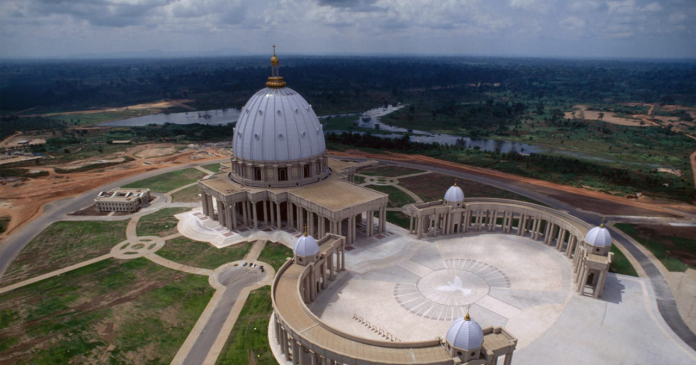The Basilica of Our Lady of Peace of Yamoussoukro stands as a monumental testament to faith and architectural ambition, nestled in the heart of Côte d’Ivoire. This grand edifice is not merely an architectural wonder but a sanctum that embodies the aspirations and spiritual devotions of a devout populace. With its vast dimensions and intricate designs, it holds the title of the largest Catholic church in the world, replete with cultural and spiritual significance that invites contemplation and reverence.
Constructed between 1985 and 1989, the basilica is an awe-inspiring structure designed by the Italian architect, Pierre Fakhoury. Its striking resemblance to St. Peter’s Basilica in Vatican City is evident, yet its unique character resonates deeply within the African context. The majestic dome ascends to a height of 158 meters, complemented by stunning stained-glass windows that bathe the interior in a kaleidoscope of vibrant hues, juxtaposed against the pristine white façade. This visual splendor evokes a sense of the divine, drawing in visitors and worshippers alike, allowing for reflection upon the celestial and the sacred.
The basilica does not simply serve as a place of worship; it also holds the title of the largest church in terms of interior space, dwarfing even the famed St. Peter’s Basilica. With a seating capacity of 18,000, inclusive of an additional area for standing, it is a venue where thousands gather to participate in solemn ceremonies, jubilant celebrations, and communal worship. The sheer scale of the structure, both externally and internally, accentuates a principle found throughout Christianity: the notion of the church as a gathering space for believers united in faith.
From a theological perspective, the Basilica of Our Lady of Peace embodies the notion of grace and sanctuary. The name itself alludes to the Blessed Virgin Mary, a pivotal figure in Christian doctrine, revered for her purity and maternal love. The basilica stands as an invitation to seek solace in a tumultuous world, reinforcing Mary’s position as the intercessor and a figure of peace. This holistic approach to worship, where art, architecture, and spirituality converge, creates an environment conducive to deepening one’s faith.
Moreover, this ecclesiastical landmark is not remote from its societal context. The basilica was commissioned by Félix Houphouët-Boigny, the first President of Côte d’Ivoire, who envisioned it as a symbol of peace and unity for a nation emerging from its struggles. The church is emblematic of the Ivorian identity, weaving together the threads of Christianity with the cultural tapestry of the region. Thus, it serves as both a local and a broader religious symbol, underscoring the universality of the Christian faith that transcends geographical boundaries.
Interestingly, the Basilica of Our Lady of Peace challenges traditional conceptions of church architecture. Unlike many historical churches that are intricately entwined with the past, this basilica emerges from a modern lens. Its contemporary design incorporates traditional African elements, thereby fostering a dialogue between the historical and the contemporary. The monumental portico, adorned with statues and sculptures, echo the devotional art of the early Church yet reframes these echoes within a distinctly Ivorian context. This blending of styles offers a fascinating narrative on how the global Church expresses itself amidst various cultural backgrounds, rendering it both a pilgrimage and an artistic destination.
Visitors to the basilica can expect to encounter a multifaceted experience. Guided tours provide insights into not only the architectural features but also the spiritual significance imbued in its construction. Each corner of the basilica tells a story, from the intricately carved wooden altars to the elaborate murals that depict biblical scenes, inviting pilgrims to engage with the sacred narrative. The artwork, infused with color and symbolism, speaks to the history of Christ and His teachings, encouraging contemplation and meditation for all who wander through its hallowed spaces.
Add to this the role of the basilica in the local and global community. It acts as a center for ecumenical dialogue, inspiring connections between believers of various backgrounds and denominations. The annual celebrations, particularly those in honor of the Virgin Mary, are occasions that gather thousands, uniting diverse expressions of faith into a harmonious melody of worship. Such events not only strengthen local ecclesiastical bonds but also connect the Ivorian church with the global Catholic community, fostering a profound sense of belonging among the faithful.
Furthermore, the basilica serves as a beacon of hope and an ambassador for social justice within the region. It undertakes various charitable initiatives, echoing the message of Christ to serve those in need. By providing aid and nurturing those less fortunate, the basilica illustrates the Catholic Church’s commitment to the teachings of Jesus—compassion, love, and service to humanity. This is particularly pertinent in a context where socio-economic challenges persist, and the church steps forward as a harbinger of hope and restoration.
In conclusion, the Basilica of Our Lady of Peace of Yamoussoukro encapsulates the essence of Catholicism through its grandeur, spiritual significance, and social engagement. It is not merely a physical structure; it represents a confluence of faith, culture, and the aspiration for peace. As millions traverse its expansive halls, they are not simply witnesses to architectural brilliance but participants in a living testament to the enduring power of faith that meets grandeur in both vision and reality. For the faithful, it stands as more than an emblem of physical size; it is a spiritual fortress that inspires and uplifts.



